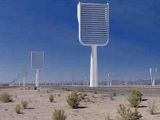Designing fossil fuel-based power plants outfitted with carbon-capture and -storage (CCS) technologies seems to be a lot to ask from the industry. The equipment required for such technologies to function is still prohibitively expensive, and their efficacy has yet to be fully tested because of this. But engineers are now proposing an alternate solution, which they say could be ready within the next ten to 20 years. They argue that forests and sidewalks adorned with “artificial trees” could aid CCS efforts to a great extent, the BBC News reports.
The UK-based Institution of Mechanical Engineers (IMechE) believes that geoengineering is the best solution we have of mitigating the effects of global warming and climate change, considering that other wide-scale projects, such as the CCS, are extremely difficult to apply, and run into financial and political barriers all the time. They believe that artificial tree “forests,” comprised of as much as 100,000 such devices, could provide a much needed drop in carbon dioxide (CO2) levels in the future.
The gas has been in numerous studies linked directly to the deterioration of the planet's climate, and is now believed to be the main agent behind global warming, together with methane, freons and other dangerous agents. However, the new author of the paper, Dr. Tim Fox, told the British news agency that this proposal was not meant to be efficient on its own. Rather, it could have positive results if it were to be used in conjunction with other mitigating measures, such as decreasing the overall level of pollution and reducing the CO2 emissions of coal, oil and natural gas-based enterprises.
“Artificial trees are already at the prototype stage and are very advanced in their design in terms of their automation and in the components that would be used. They could, within a relatively short duration, be moved forward into mass production and deployment,” Fox said. The IMechE team only selected three options from the hundreds they studied over the years, as possible ways of reducing the effects of global warming. The main criteria behind their selections were for the final choices to be constructed with the existing technology, and also for them to have a low-carbon footprint.
“We very much believe that the practical geoengineering that we are proposing should be implemented and could be very much part of our landscape within the next 10 to 20 years,” the expert added. The Institution has also asked the UK government for approximately ten million pounds in funding, so that it could run an effectiveness, risk and cost analysis on the methods it presented and offer a final conclusion.

 14 DAY TRIAL //
14 DAY TRIAL // 
